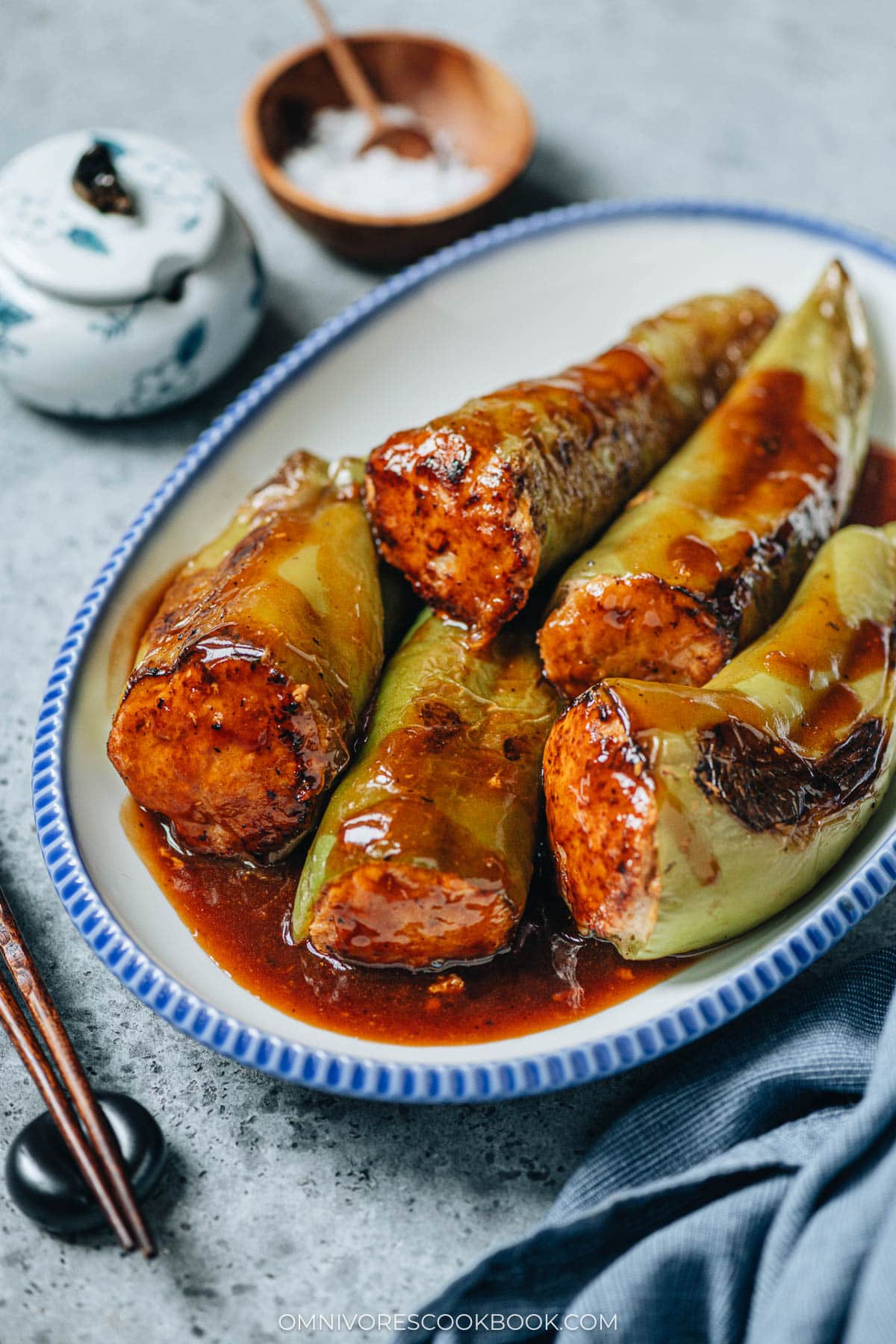
Stuffed peppers are a very popular dish across China, and each region has their own version and flavor profile. Some of the most well-known stuffed peppers are from Cantonese dim sum, usually using a smooth shrimp or fish filling to stuff the bell peppers, finished up with a black bean sauce. In this post, I want to share a Northern Chinese stuffed pepper recipe. Different from the Cantonese version, my recipe uses ground pork for the filling, with water chestnuts for texture. The peppers are pan grilled, then briefly braised in a garlicky brown sauce for a rich flavor.
The finished dish is satisfying and hearty. It’s easy enough to put together on a weeknight, and impressive enough for a Sunday dinner centerpiece.
Ingredients
What type of pepper to use?
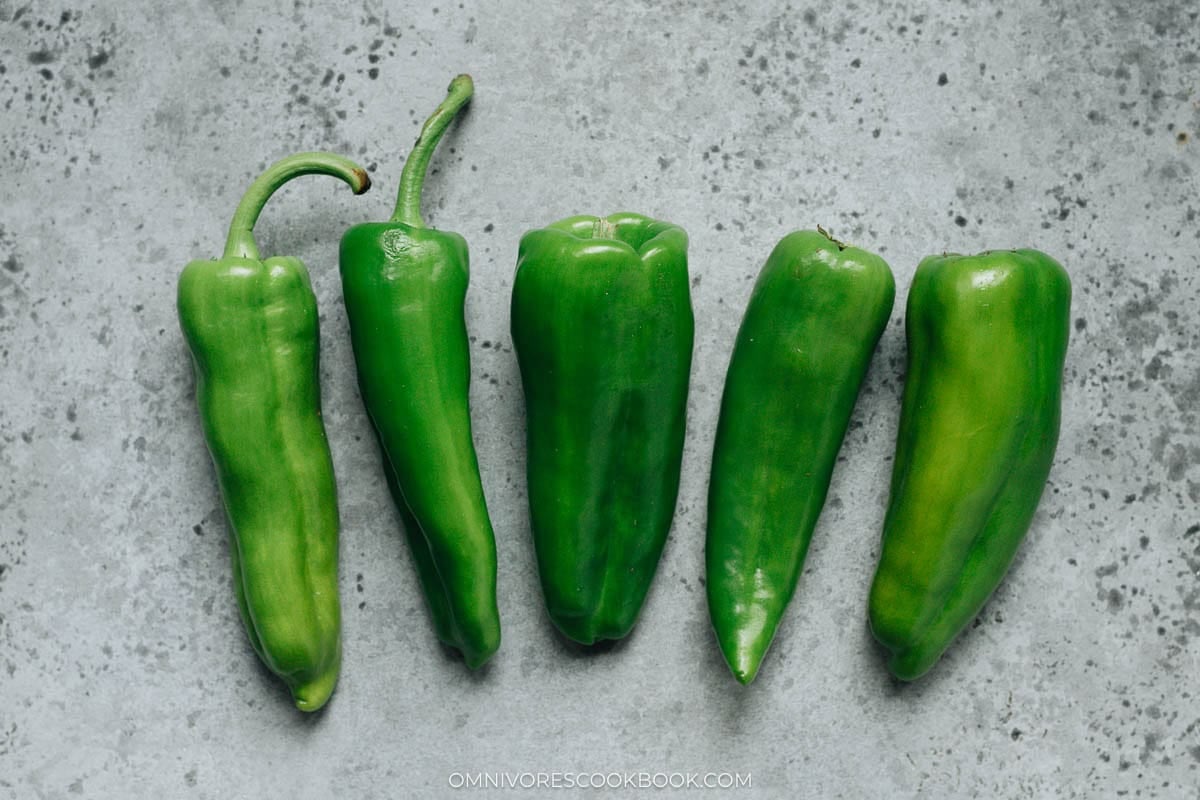
My favorite pepper for this dish is Cubanelle pepper, or Cuban pepper. It is a mild, sweet pepper with a little heat. It is not too big to cook with and yet not too small to stuff. The skin is thin, very similar to the type of pepper we use in China. Alternatively, Anaheim pepper is another great option that is quite similar to the Cuban pepper.
When picking Cuban peppers, try to use the ones on the smaller side with a straight shape. So it will have a nice pepper-to-filling ratio and be easier to stuff.
I prefer not to use bell peppers since most that I’ve found in the US are quite large and have thick skin. If you want to use bell peppers for this dish, I would slice the peppers into shallow boats (a little smaller than half of a bell pepper) that’s about 1” deep. So it achieves a similarly sized stuffing.
The stuffing
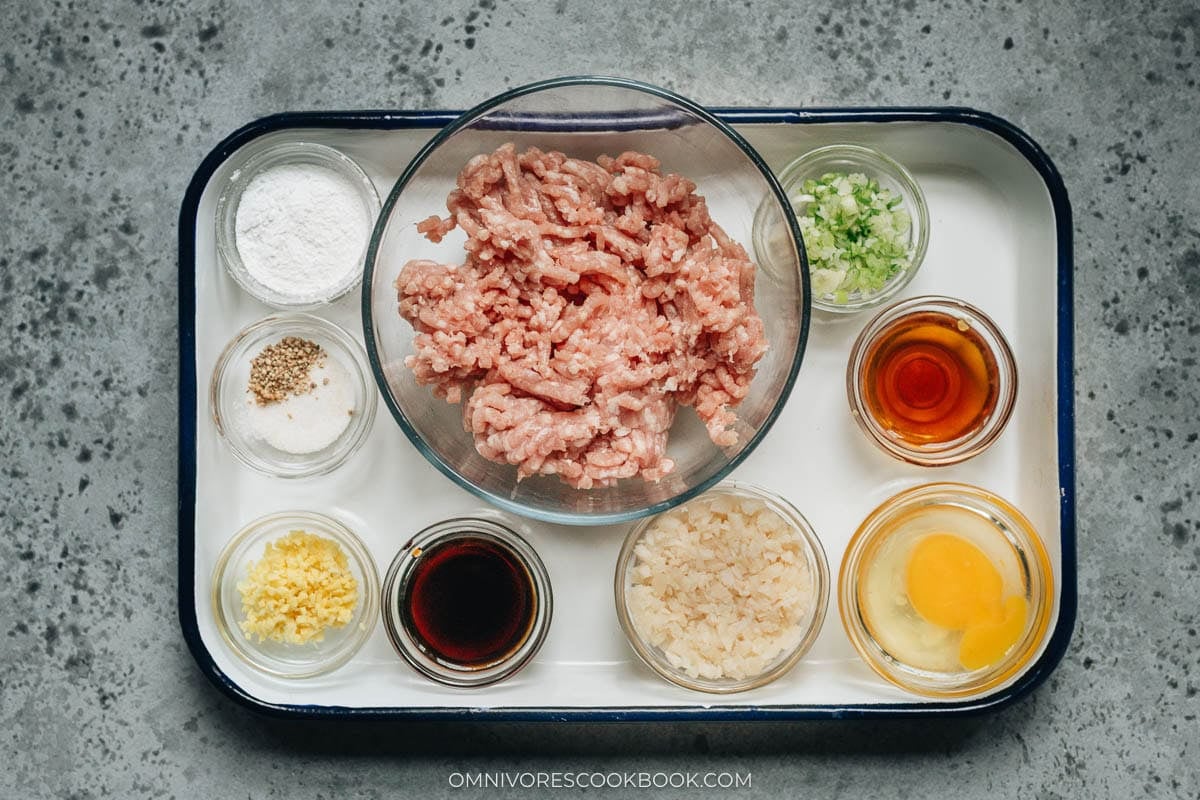
In Northern China, ground pork is the default filling for stuffed pepper. My recipe uses Shaoxing wine and soy sauce for umami, and ginger and scallion for fragrance. I also add minced water chestnuts for a crunchy crispy texture. The egg and cornstarch work as a binder and tenderizer.
The sauce
I use a simple brown sauce to braise the peppers. It is chicken stock based, with soy sauce and oyster sauce for flavor. The dark soy sauce adds a nice deep brown color to the sauce. Sugar is used as a hidden flavor to balance out the saltiness, and garlic is added for fragrance.
How to make
Mix all the filling ingredients together. Make sure to beat the filling in one circular direction until it becomes sticky. This helps ensure that the filling binds together and doesn’t fall out of the peppers.
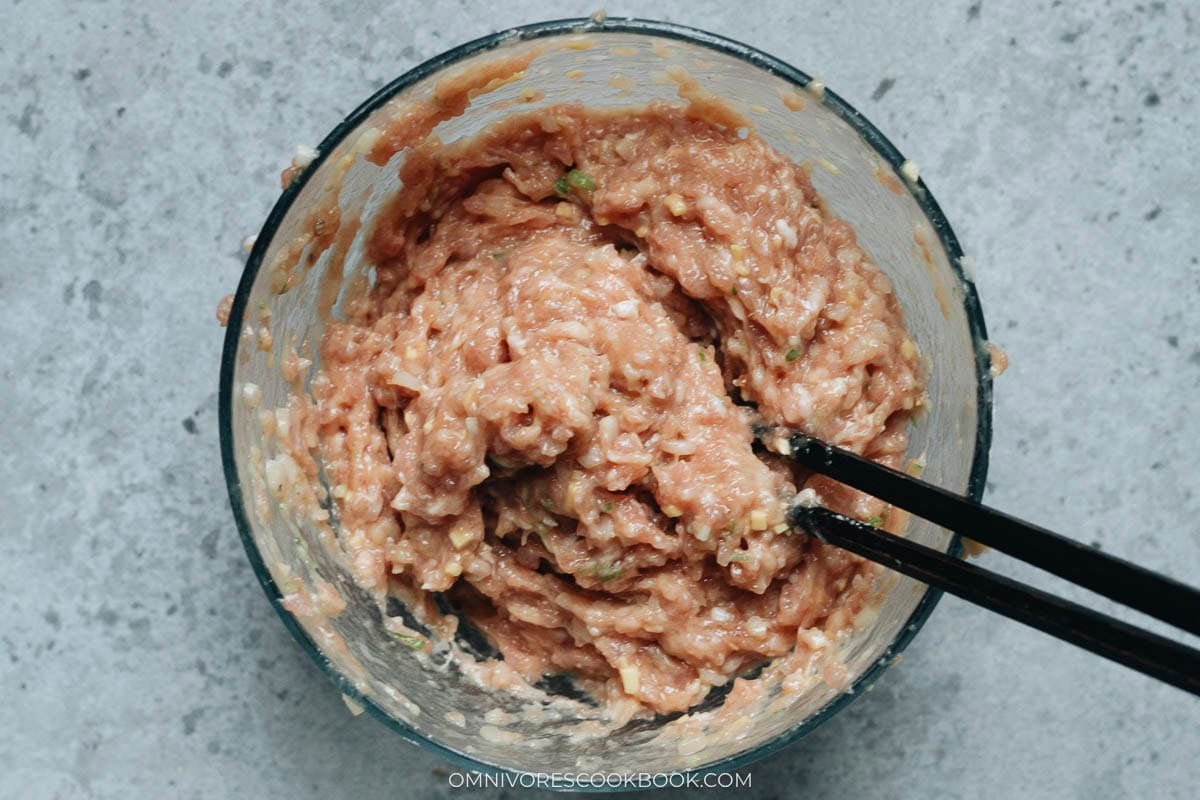
To stuff the peppers, cut off the tops and remove the seeds as thoroughly as you can using a paring knife. Use a small spoon with a long handle to stuff the filling. Make sure to pack in as much filling as you can. If you don’t have enough filling to stuff the final pepper, simply cut off the ends of the unfilled pepper. This will ensure better browning later on.
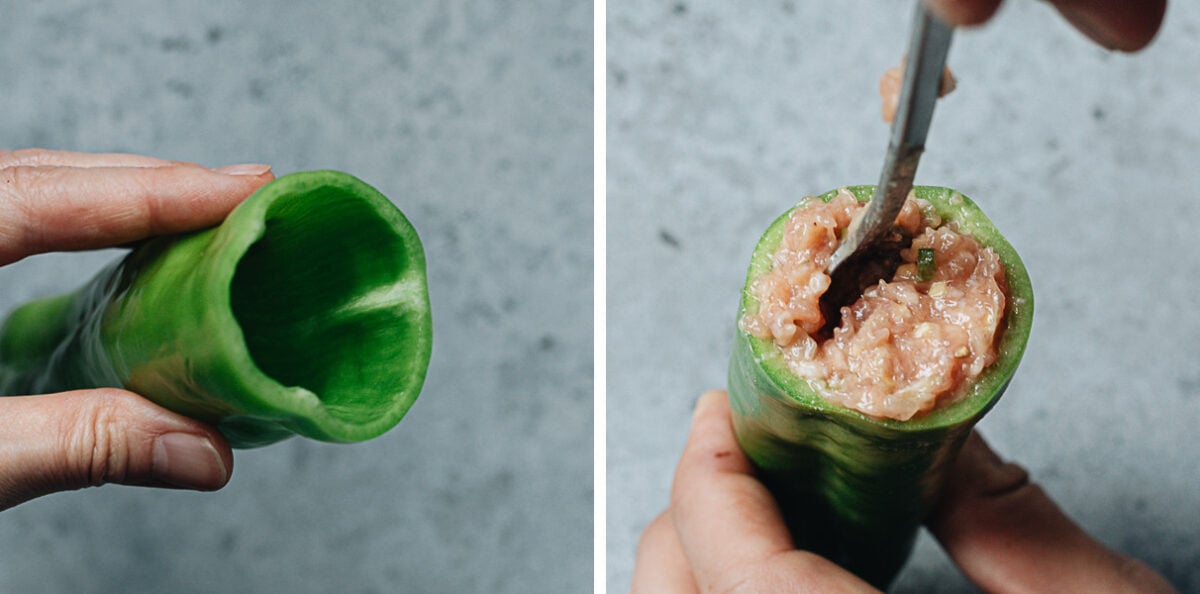
Grill the peppers in a hot pan until the surface is blistered. To char the peppers properly, first make sure to dry the pepper surface as thoroughly as you can to prevent splatter. Cook the peppers in a hot pan and do not move them. Let them cook for at least two minutes before checking, and it usually takes three minutes to brown each side. If the pan starts to smoke heavily, turn to medium heat. Blister all sides to create a nice texture.
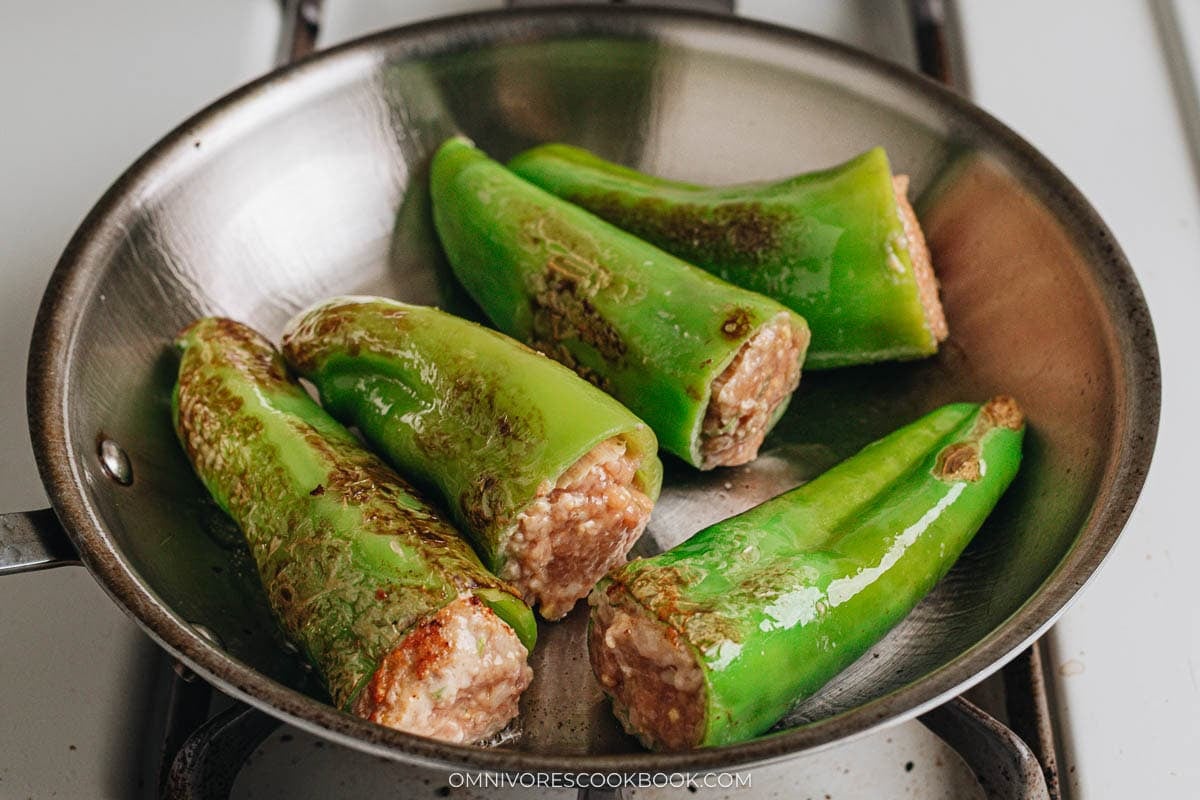
Once all sides of the peppers are charred, brown the meat stuffing side. Nicely shaped Cuban peppers can usually stand up by themselves in the pan. If they don’t, use a pair of tongs to char one pepper at a time.
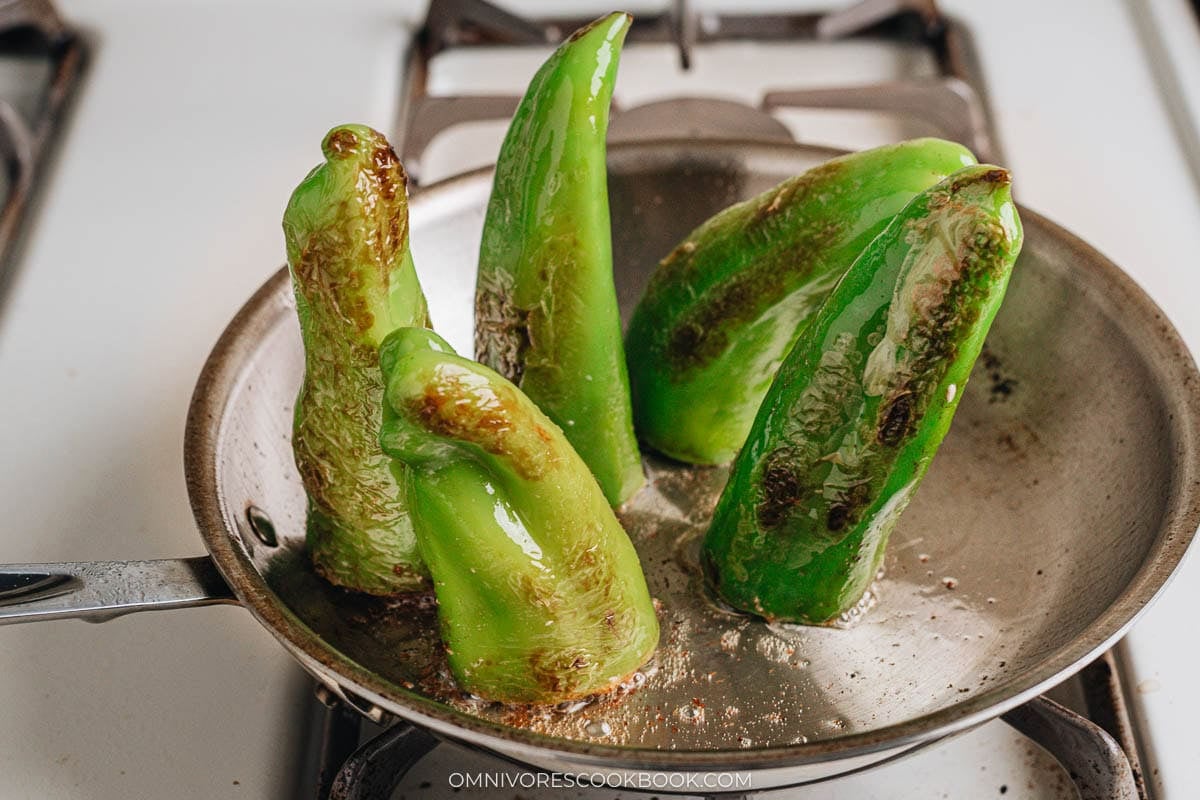
Pour in the sauce and cover the pan. Braise for 5 minutes, until the filling is cooked through.
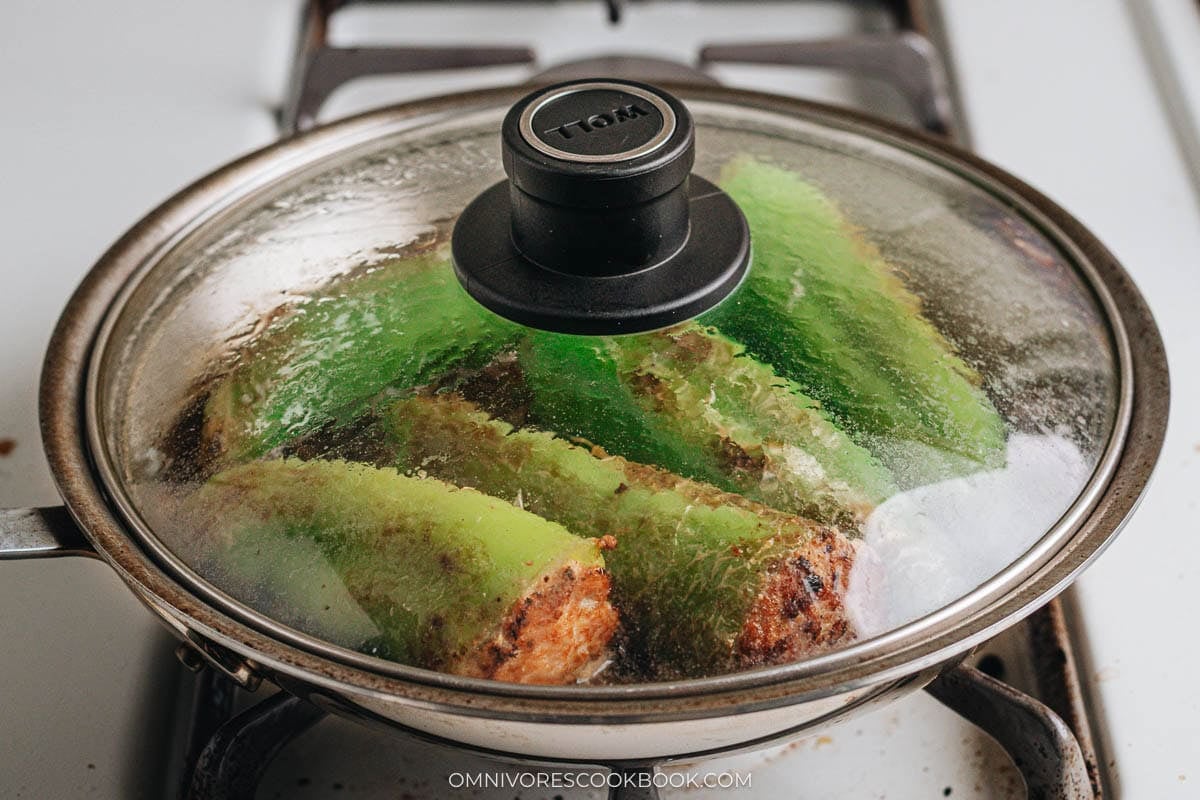
Then transfer the peppers to a serving plate. Add the cornstarch slurry to thicken the sauce.
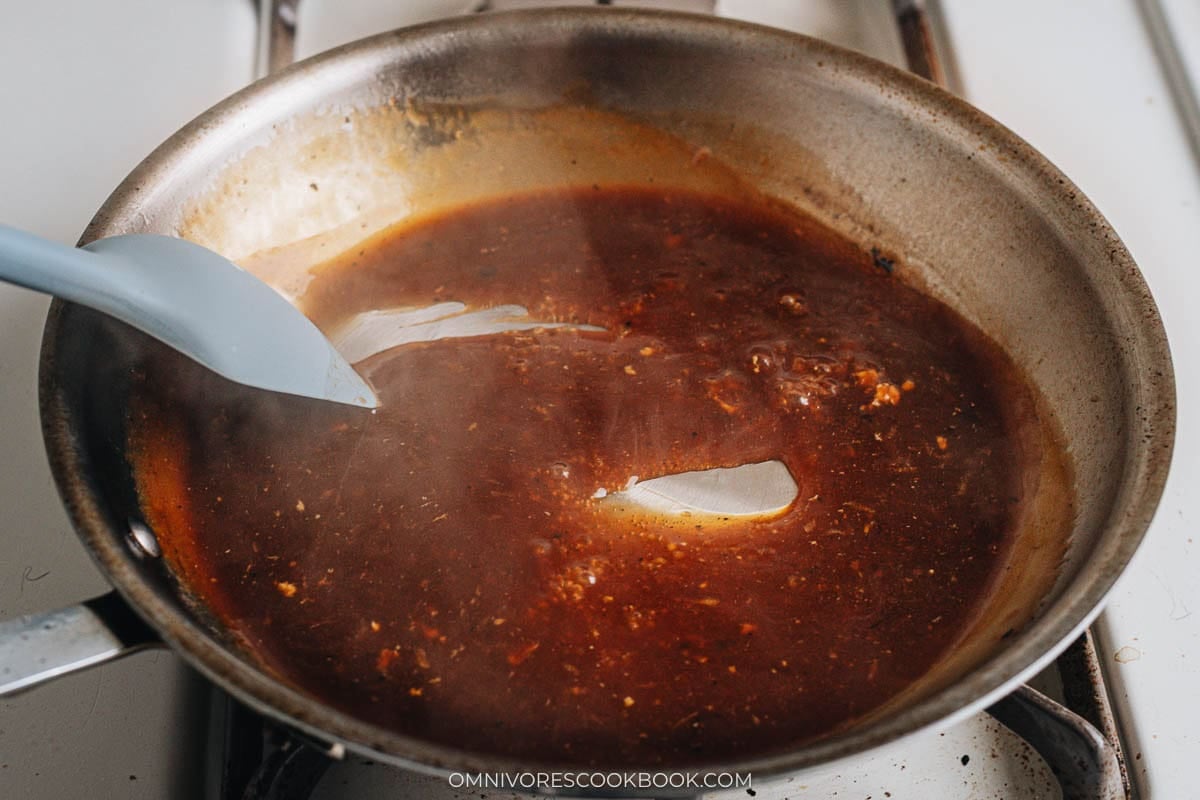
Pour the sauce over the plated peppers to finish up the dish.
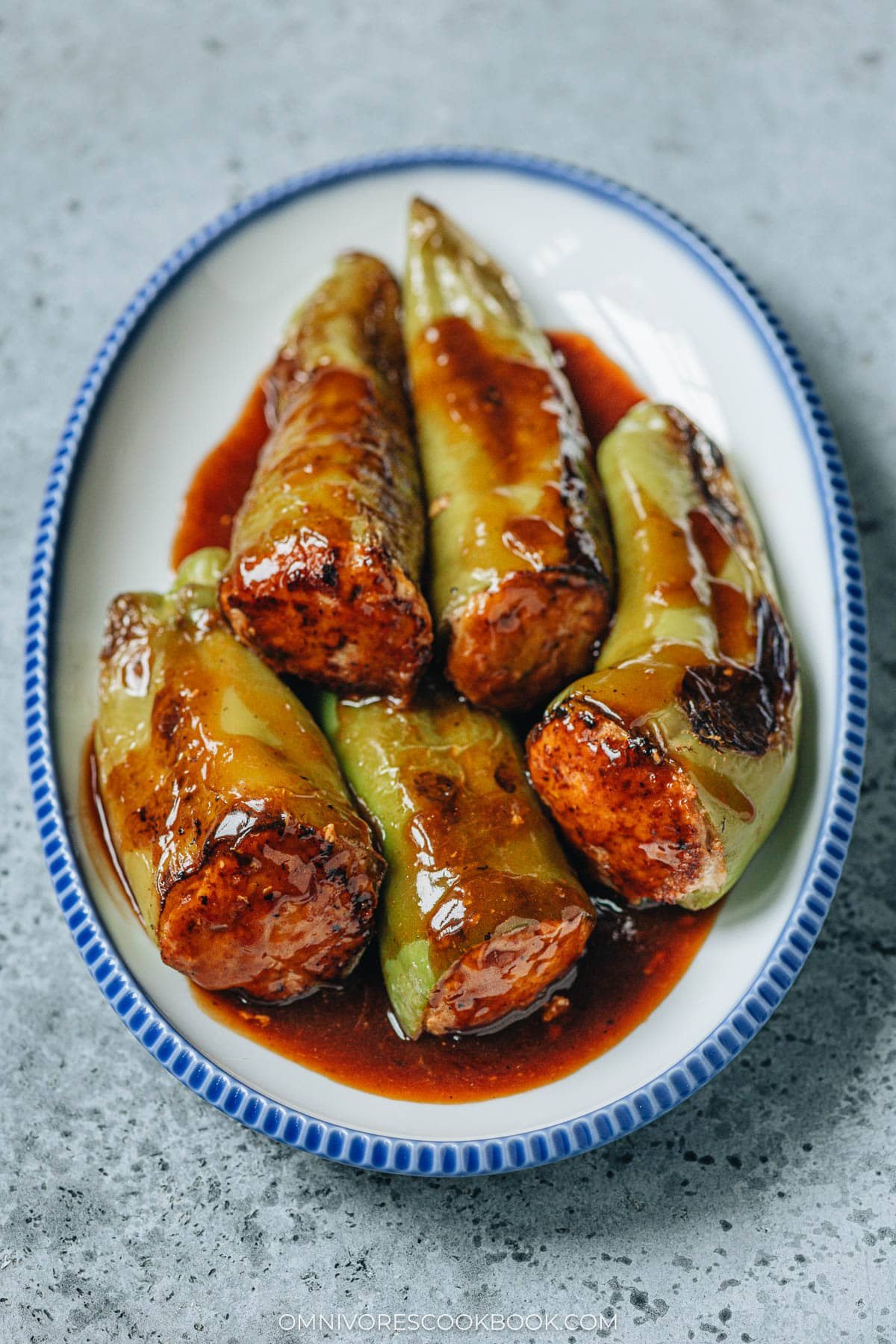
How to serve
You can serve these stuffed peppers as a main course by itself, but I really like to serve it with steamed rice. It’s also great to serve the dish as a centerpiece of a larger meal, along with an appetizer, soup, and sides. Here are some pairing suggestions:
- Tomato Egg Drop Soup
- Wood Ear Mushroom Salad (凉拌木耳)
- Spicy Eggplant Salad (凉拌茄子)
- Peanut Noodles
- Easy Egg Fried Rice (蛋炒饭)
Frequently asked questions
Can I use an air fryer instead of pan-frying?
I do not recommend using an air fryer because the pepper and filling won’t brown as well as they would if pan fried. If you decide to use an air fryer, I would spray oil over the peppers, then use the highest temperature setting until the surface is blistered. Then finish the rest of the cooking in the pan.
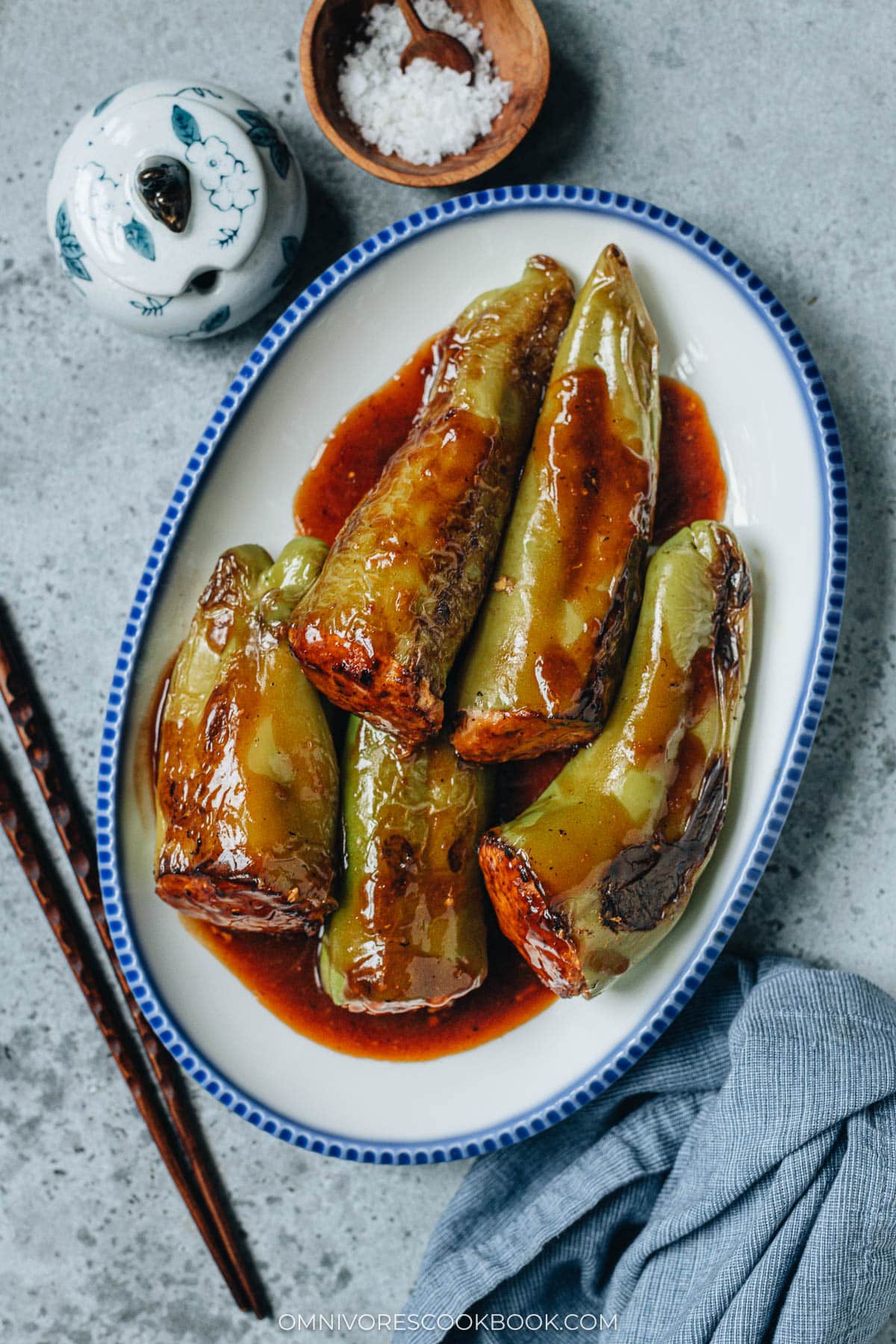
Chinese Cooking Made Easy
Are you new to this website? This free email series is a great place to start. I’ll walk you through a few of my most popular recipes and show you how and why they work. You’ll quickly start to cook better Chinese food in your own kitchen.
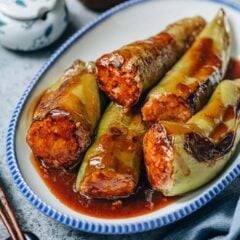
Chinese Stuffed Peppers (青椒酿肉)
Ingredients
- 5 Cubanelle peppers (or anaheim peppers) (*Footnote 1)
- 1 tablespoon vegetable oil
- 2 teaspoons rice vinegar
Stuffing
- 1/2 lb ground pork
- 1 tablespoon Shaoxing wine
- 1 tablespoon soy sauce
- 1/4 cup water chestnut , coarsely minced
- 2 teaspoons ginger , minced
- 1 scallion , minced
- 1 egg
- 1 tablespoon cornstarch
- 1 teaspoon sugar
- 1/4 teaspoon white pepper
Sauce
- 1/2 cup chicken stock
- 1 tablespoon soy sauce
- 1 tablespoon oyster sauce
- 1 teaspoon dark soy sauce
- 1/2 teaspoon sugar
- 1 clove garlic , grated
Slurry
- 1 teaspoon cornstarch
- 1 tablespoon water
Instructions
- To prepare the chili peppers: Cut off the ends and remove and discard the seeds.
- Mix all the stuffing ingredients together in a medium-sized bowl. Stir until the paste becomes sticky. Stuff the meat into each pepper, using a long spoon to push the filling down, to pack in as much filling as you can. If you don't have enough filling to fill the last pepper, cut off the part that is not filled. Dry the peppers with paper towels so the surface is dry, to prevent splatter.
- Mix all the sauce ingredients together in a small bowl.
- Heat the oil in a large skillet over medium-high heat until shimmering. Add the peppers. Let cook, flipping occasionally, until the surface has blistered, about 3 minutes per side. Then use a pair of tongs to stand the peppers up on their ends to brown the filling. Turn to medium heat if the oil starts to splatter.
- Pour in the sauce and cover the pan. Let simmer for 5 minutes, flipping the peppers halfway through, until the meat stuffing is cooked through.
- Mix the cornstarch and water until the cornstarch dissolves completely.
- Uncover the pan, then transfer the peppers onto a serving plate. Pour the cornstarch slurry into the pan, stirring immediately until the sauce thickens. Turn off the heat and pour the sauce over the peppers. Splash with the rice vinegar. Serve hot as a main dish.
Notes
- Both cubanelle peppers and anaheim peppers are suitable for this dish because they are mild and have thin skin. Their size is just right for stuffing.
- To make the dish gluten-free: Use dry sherry to replace Shaoxing wine, use tamari to replace soy sauce and dark soy sauce, and make sure to use a gluten-free oyster sauce.
Nutrition

Did you make this recipe?
I’d love to hear how it turned out for you! Please take a moment to leave a 5-star rating ⭐️ and share your thoughts in the comments further down the page. It really helps others discover the recipe too.

Paola
Hi Maggie,
What was the rice vinegar for? Did I miss something?
Thanks
Paola
Maggie Zhu
Sorry about that! I just updated the recipe. You should splash the rice vinegar onto the dish at the end. It brightens up the flavor of the dish.
AliceK
Maggie, you’ve done it again! Easy and delicious! This is a little different from the food we usually are served in local Chinese restaurants, which tends to be Cantonese influenced. I think I really like Northern Chinese dishes. Keep ’em coming! I used Hungarian wax peppers for this dish.